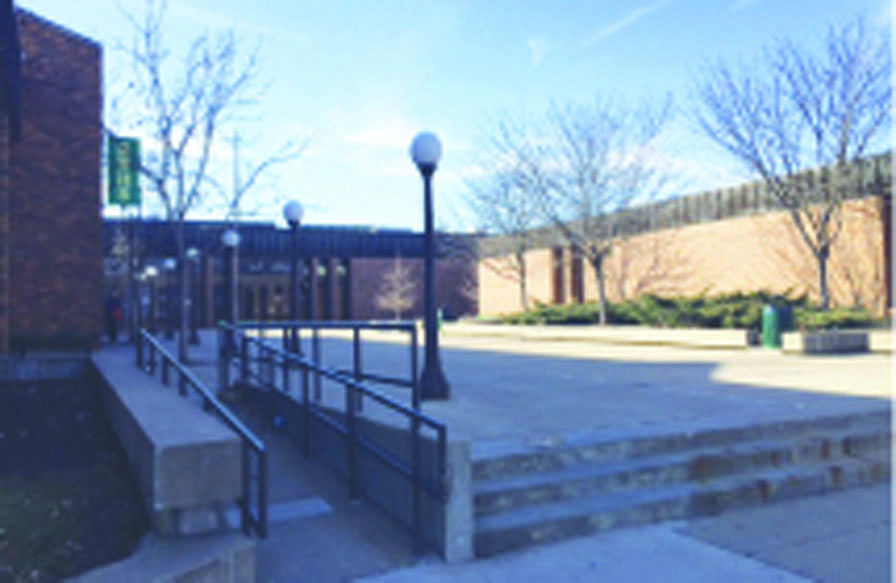A photo of the Emerald Regiment hangs in a thin, black frame on the wall just to the right of practice room D. The green uniforms are shown as black and white in the photographs, with a black sash lined with gold stitching hanging diagonally across the wearer’s torso. Faces are blurred, but still show smiles and instruments held up proudly.
The photo is from 1977.
Just outside, in the main performing arts hallway, lies glass cases containing achievements of the choirs
and show choirs past. Directly across the hallway are pictures of all the show choirs RBHS has obtained dating all the way back to 1988. The basics of RBHS history are known to most, but the details are a foreign language.
The marching band has been at RBHS for more than 36 years, but the history and origin of the name is an aspect known by few.
“The marching band was going to be called the “Marching Trolls,” band director Steve Mathews said. “The uniform was green, and on the back there was a little bridge with a troll under it because trolls live under bridges.”
Although the “Marching Trolls” never had their reign as the RBHS marching band, director Phil Wood led what was the RBHS marching band until his term ended. The Emerald Regiment made their 2010 debut after the name was suggested by Mathews. Before the marching band was created, the band without uniforms was called the “Marching Munchkins.”
“I’m honestly scared they would ever even suggest that name, both Marching Trolls and Munchkins,” senior Allie Rodgers, drum major of the 2015 Emerald Regiment said. “No one would take us seriously.”
Although new drum majors and students arrive each year, they have all been relatively the same, Mathews said. He describes the students he’s encountered in the band program during the six years he’s been teaching as always talented, but small in comparison to the band now, with the relatively new addition of freshmen.
“Freshmen have brought our band up for the better,” Mathews said. “Both in numbers and with more talent.”
Mathews, the third band director at RBHS, succeeded Rich Hadfield. Hadfield is a freelance percussionist and took part in the RBHS band program.
“RBHS’ facilities and faculty fostered my growth and encouraged experimentation in a crucial time of my development,” Hadfield said.
Hadfield felt relaxed during his time at RBHS, but also stimulated to work creatively. RBHS percussion also prepared him for his future at New York University (NYU). and his appearances in Saturday Night Live’s live band and the musical pit of several Broadway shows. Hadfield’s musical legacy inspires sophomore Reuel Braid.
“It’s pretty cool because when you think of Al Chez, Tom Garling and other successful musicians who we have had here as guest artists,” Braid said. “They started in towns our sizes and bands like ours,”
Braid stood by as freshman Savannah Wittman squealed as she discovered Rob Benedict graduated from RBHS in 1989, and now he’s an actor in Los Angeles, California. Benedict plays Chuck Shurley in the well-known CW television show Supernatural. He also hosted sketch comedy show “Die Laughing” of which well known actor and comedian Zach Galifianakis performed in. But before all this, Benedict was a RBHS student, who found his calling in his theater class, with teacher Jennifer Black Cone.
“Theater is a tough profession,” Black Cone said. “But Rob understood it. He had the traits needed to make it in the industry.”
Black Cone said Benedict has always been very different. Both his mother and father were involved with other performing arts. He was always very busy both inside and outside of school.
“He was involved in so many things I felt like I had to fight for his attention,” Black Cone said. “Even with everything going on, he had the drive he needed to do it all.”
With RBHS’ production, The Night of the Living Dead, showing for three days with four shows and having rehearsal each night before, the theater program has not slowed down with the drilling of young actresses and actors. These students are trying to make it big, just as Rob Benedict has, sophomore Roz Eggener said.
“He makes me feel like I can do it,” she said. “He gives me the motivational push to keep going through the program even if I feel like stopping.”
Benedict isn’t the only RBHS student turned star. Justin and Melissa Bohon were also shown in light at RBHS during the reign of their father, Bob Bohon. He was the vocal instructor for nearly 30 years and worked to establish the performing arts program at RBHS.
Justin and Melissa Bohon both went through the choir and show choir programs at RBHS, and both used that experience to guide their futures. Justin Bohon won the Astaire Award, an award for exceptional dancing in a Broadway production, in his starring of Oklahoma, while his sister Melissa Webel was the lead role in the National Tour of Wicked. Justin Bohon graduated RBHS in 1996, and Melissa in 1999. The Bohons are just two examples of the talent walking through RBHS halls and out the doors to a brighter future.
“They show how kids who have been to RBHS can make it far in the world due to the choir program,” freshman Adam Vincent said.
The father of Justin and Melissa Bohon, Bob Bohon was the vocal instructor for nearly 30 years and worked to establish the performing arts program at RBHS. Bohon was also the director when Dr. Jennifer Rukstad, the current principal, was in show choir.
With 18 students in 1993 and 20 in 1994, show choir has dramatically grown with every year. This year, there are more than 60 performers in City Lights and Satin n’ Lace combined. In show choir’s early days, there were no risers and no Performing Arts Center. They were built in 1993, Rukstad’s first year in show choir. Now there is a new set built for each new show in both Satin n’ Lace and City Lights along with two or more costume changes.
City Lights earned its name in 1993 after their show about traveling and cities. Their attire was green sequin dresses with black gloves for the girls and black pants with a green vest for the boys. These costumes remained for the years 1993-1995. Now, the Show Choirs have new clothing for each new show.
“We had boas,” Dr. Rukstad said. “My second year we took off jackets for our costume change.”
Not only were the costumes different and less elaborate than the current ones, the whole show choir name was different.
“Before that, we were just the RBHS Show choir,” Dr. Rukstad said. “City Lights just stuck, and 20 some odd years later it’s still here.”
Satin n’ Lace was created in 1995, a year after Dr. Rukstad graduated. Twelve years worth of students have graduated under the eye of current director of choirs Mike Pierson. Although Pierson notices students have grown in maturity and whole-mindedness, they have all been relatively the same but with a generation of personalities.
“In general, the performing arts programs look very similar to how they did,” Pierson said. “The only real change was the addition of freshmen.”
Mathews has also seen performing arts programs change and grow over his 30-plus years of teaching music. From Northern California to Missouri itself, Mathews has instructed thousands of students and taught a range of youth and high school concert bands, jazz bands and marching bands.
“Students are getting more serious and responsible, they’re taking more ownership of the program,” Mathews said. “That’s probably the biggest difference in the program.”
Categories:
Performing arts inspire
May 19, 2016
0
More to Discover

















































































